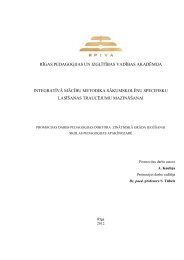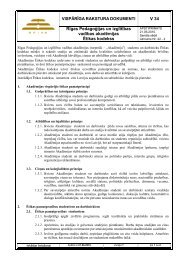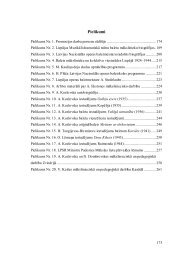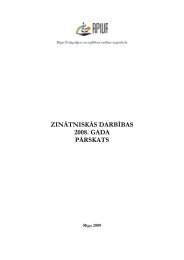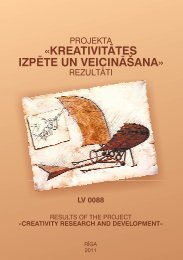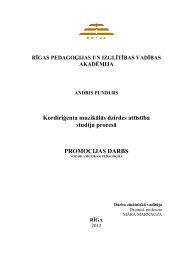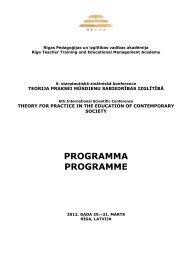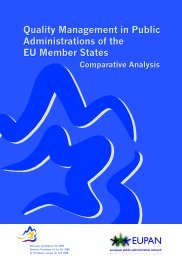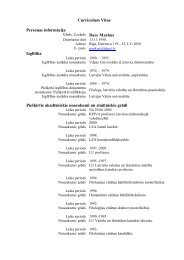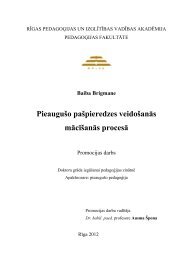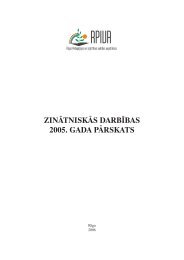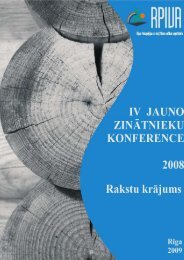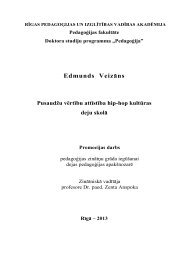saturs - rpiva
saturs - rpiva
saturs - rpiva
- No tags were found...
You also want an ePaper? Increase the reach of your titles
YUMPU automatically turns print PDFs into web optimized ePapers that Google loves.
authors’ personal PowerPoint presentation was shown, which served the dual functions:<br />
PowerPoint presentation on introducing ourselves as well as explaining the nature of the<br />
course. A project that students had completed during the previous term also was shown.<br />
While viewing both presentations, students were asked to consider the following questions:<br />
What is the PowerPoint presentation and project about What kind of information<br />
does the PowerPoint presentation and project provide What is the aim of the PowerPoint<br />
presentation and project What is the audience for the PowerPoint presentation and project<br />
What do you think of the PowerPoint presentation and project design What is your opinion<br />
of the PowerPoint presentation and project How does it facilitate EFL learning/teaching<br />
Focusing on the questions above, during the second lecture students worked in pairs<br />
to evaluate PowerPoint presentations and projects in EFL made by other students (see<br />
Appendix 1). So the activities introduced students to possible projects and allowed them to<br />
analyze features of PowerPoint presentations and projects they found on the Internet.<br />
Module 2. Defining and Planning Their Projects<br />
Students planned and gathered information for their project and presentation. These<br />
lectures began with a demonstration of a certain procedure, which was projected to a<br />
whiteboard from the computer. For example, students watched materials, and then they<br />
repeated this procedure on their own computers.<br />
Then students were ready to define the scope of their project. They had selected an<br />
appropriate topic and formed groups or decided to work individually; they worked on a<br />
proposal for their project (see Appendix 2). To complete the proposal, they needed to consider<br />
the purpose of their project, their audience, and how they would organize their project and<br />
PowerPoint presentation slides. The proposal also encouraged students to focus on the various<br />
tasks involved in the project and identify the steps needed to complete these tasks. For<br />
example, would they need to interview teachers, do research on the Internet, or make a<br />
glossary During the planning stage, students assigned roles to different group members and<br />
completed Action Plan 1. They listed the tasks that needed to be done, the group member<br />
responsible for completing the task, and the amount of time needed for each task.<br />
Module 3. Gathering Information and Researching, drafting, revising and<br />
producing their final PowerPoint presentation<br />
In module 3, students gathered information for their project. Many groups researched<br />
the Internet, in the library, interviewed teachers and students or conducted short<br />
questionnaires. At this point, the class became very student-directed and -centred. Students<br />
had their action plans, so they knew what they needed to accomplish in each class. Instead of<br />
fronting the class, the role of the authors of this article became more of a mentor or consultant<br />
to the different groups. Fried-Booth (1986) describes the typical role of a teacher in project<br />
work as that of co-coordinator.<br />
Drafting. Before they began drafting their pages, students needed to work as a<br />
cooperative team to complete Action Plan 2, which focused on writing and designing their<br />
project and PowerPoint presentation. During this process, they assigned different tasks to each<br />
group member based on her interests and skills. For example, some groups gave each member<br />
a different slide to draft. Other groups divided the work between designing the slides and<br />
paraphrasing information found on the Internet.<br />
Module 4. Presenting, defending and reflecting on their project (Self-reflection<br />
and Teacher Feedback and Revision)<br />
In module 4, the first draft of the project was due. Groups signed up for a feedback<br />
session, in which we gave them advice on content, design, organization, and presentation. As<br />
soon as we gave the group feedback, they were required to complete Action Plan 3, which<br />
focused on revision. In the end of the final module, students revised their project (see<br />
Appendix 3). Students' projects varied in content, purpose, design, and organization.<br />
145



